Canfield Lithium
Test Location: Gunnison-Crested Butte, Colorado
Test Duration: 3 months
Size Tested: Large
Wheel Size: 29”
Travel:
- Rear: 163 mm w/ stock 65 mm stroke shock; adjustable to 151 mm with 60 mm stroke
- Front: 170 mm
Stated Weight:
- 7.7 lb (3.5 kg) frame only
- 8.8 lb (4.0 kg) frame and shock
- 31.8 lb (14.4 kg) complete bike
Price:
- Frame only: $1,950
- Frame w/ shock: $2,350–$2,800
- Frame and fork packages: $3,650–$4,750
- Complete bike: $5,600–$7,100

Intro
Earlier this year, Canfield Bikes introduced a new 29er bike, the Lithium, with 163 mm of rear-wheel travel. As per usual for Canfield, the Lithium is available with an aluminum frame only and features Canfield’s CBF suspension — which we were very impressed by on the Revel Rail — along with modern, but not over-the-top aggressive geometry.
Having now spent several months on the Lithium, we’ve found it to be an especially versatile long-travel bike that’s still highly capable in burly terrain and at high speeds, too.
The Frame
The Lithium is offered in aluminum only, and features internal cable routing through the downtube and then out along the seatstays for the rear brake and derailleur cables. The threaded bottom bracket shell is a welcome move, and the Lithium uses post-mount rear brake tabs sized for a 180 mm rotor. Removable ISCG ‘05 tabs are included, and while there is one set of water bottle mounts, the shock placement pushes them to the underside of the downtube.
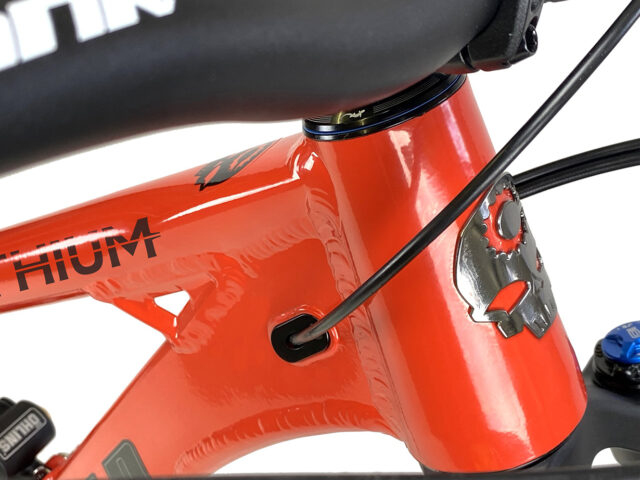

The Canfield Balance Formula (CBF) suspension layout has been around for a while now, in use on both Canfield’s own bikes, and licensed to Revel. In short, it’s a mini-link design, in which Canfield has aimed to keep the Instant Center (IC) and Center of Curvature (CC) constrained to a narrow area near the top of the chainring throughout the bikes’ travel.
[If that last sentence sounded like a bunch of tech mumbo jumbo, don’t worry about it and focus on this next one.]
The idea with CBF’s design is to create more consistent pedaling and braking behavior throughout the travel range and offer a broader range of suspension tuning options to the rider, since the suspension isn’t as dependent on running an exact sag setting to achieve the intended performance, particularly under pedaling. While we’re always wary of bold claims like this, they did seem pretty accurate (and very impressive) when we tried CBF on the Revel Rail.
The Lithium has stated clearance for 29 x 2.5” or 27.5 x 2.8” tires and comes spec’d with a coil shock from the factory, though Canfield notes that the leverage curve is suitable for both air and coil shocks.

Options, Pricing, and Build
The Lithium is available from Canfield as a frame + shock, frame + shock + fork package, or as a complete bike. There’s only one full build kit on offer, though there are some options for customization of the wheels and suspension. Here’s a quick breakdown of the options:
Canfield Lithium Pricing:
- Frame only: $1,950
- Frame and shock:
- Öhlins TTX Air or MRP Hazzard Coil: $2,350
- EXT Storia or Arma: $2,800
- Frame, shock, and fork:
- Öhlins TTX Air and Öhlins RXF36 m.2 Air or MRP Hazzard Coil and Ribbon Air: $3,650
- EXT Storia or Arma and Era: $4,750
- Complete Build:
- MRP suspension: $5,600
- EXT suspension: $7,100
Canfield Lithium Build Spec:
- Fork: MRP Ribbon Air, 170 mm
- EXT Era available as an upgrade
- Shock: MRP Ribbon Coil, 230 x 65 mm
- EXT Storia and Arma available as upgrades
- Wheels: Canfield Special Blend AM29 stock
- Atomik Carbon AM35 w/ Industry Nine Hydra hubs available as an upgrade for $1,600
- RideFast Racing Hotline 29 for $1,550 upcharge
- Brakes: Magura MT5 or TRP Quadriem (same price for either)
- Drivetrain: Sram GX Eagle, 10-52 cassette
- Seatpost: SDG Tellis — 150 mm drop on S and M frames; 170 mm on L and XL
- Tires: Maxxis Minion DHF 2.5 front, Maxxis Dissector 2.4 rear (casings and rubber compounds not specified)
We like what Canfield has done here — they’re offering a very well spec’d bike at a price which, while not cheap, spends money where it’ll make the most difference (suspension) and goes with more value-oriented choices in sensible spots. We’d recommend an aluminum frame with better suspension over an otherwise identical carbon option with lower-end suspension in a heartbeat, at least for bikes in this sort of travel range where minimum weight isn’t often a top priority.
Geometry
The geometry of the Lithium is in keeping with modern trends, but doesn’t go all-in on the long / low / slack arms race.
The Lithium is offered in four sizes, S through XL and comes with a fairly middle-of-the-road 64.5° headtube angle. The seat tube angle is stated at 76.7° (effective), which is maybe a touch slack by modern standards, but isn’t a wild outlier.
Canfield’s website also makes the very welcome move of specifying effective seat tube angles at three stated seat heights. As we’ve mentioned many times at Blister, effective seat tube angles can be misleading, since they’re dependent on the seat height and actual seat tube angle. Stating them at three specified heights is helpful information that we’d love to see more brands offer.
[If you could use a refresher on the difference between effective and actual seat tube angle, or any of the other geometry aspects we’re discussing, check out the section on the subject in our Mountain Bike Buyer’s Guide, starting on page 60]
The reach for the Lithium ranges from 425 to 500 mm in 25 mm increments between sizes and features notably short chainstays (430 mm in all sizes). Given the very short chainstays, the decision to not go super slack on the headtube angle makes sense. Combining an ultra-long front center with very short chainstays / rear center can make for a bike that requires very aggressive weighting of the front wheel and a relatively forward body position to feel balanced, so it makes a lot of sense that Canfield has kept all the variable on the moderate side, rather than doing a mix-and-match with the geometry numbers. For reference, here’s the full geo chart for the Lithium:
Full Review
We’ve now ridden the Canfield Lithium on a wide range of trails around the Gunnison Valley. It has proven to be a pretty versatile bike — especially for what it is — but how does it compare to other long-travel 29ers on the market?
Fit and Sizing
Dylan Wood (5’11”, 155 lbs / 180 cm, 70 kg): The Lithium has a pretty standard fit compared to most Enduro bikes released in the past 2-3 years. After setting the cockpit and seat height to my preferences, I was immediately good to go.
On the size Large we tested, I found that I was not too stretched out nor too cramped — it was a comfortable fit that still let me move around the bike in the way I needed to. While Canfield’s sizing suggestions could have me on either a Medium or a Large, I am definitely happy on the Large. With a 450 mm reach on the Medium, I don’t think I would have enough room in the cockpit as I prefer (something I found on the Medium Ibis Ripley AF, which also has a 450 mm reach).
It’s also worth noting that the Canfield uses 165 mm cranks on the full builds of the Lithium. While this isn’t a huge difference compared to the 170 mm cranks I usually use, I ended up running my seat height just a smidge higher than usual (relative to the center of the bottom bracket) on the Lithium to create the ideal fit for me. Our Lithium also came with 810 mm bars, and we very quickly cut these down to 780 mm, a width that Eric, Luke, and I all get along with (Canfield has since started putting an 800 mm bar on the Lithium). I see no problem with specing bars that are too wide for some riders since it is a whole lot easier to cut bars down than to buy a whole new, wider handlebar.
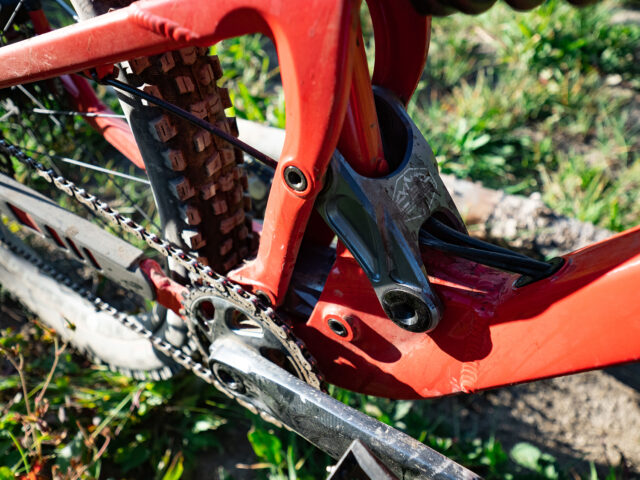
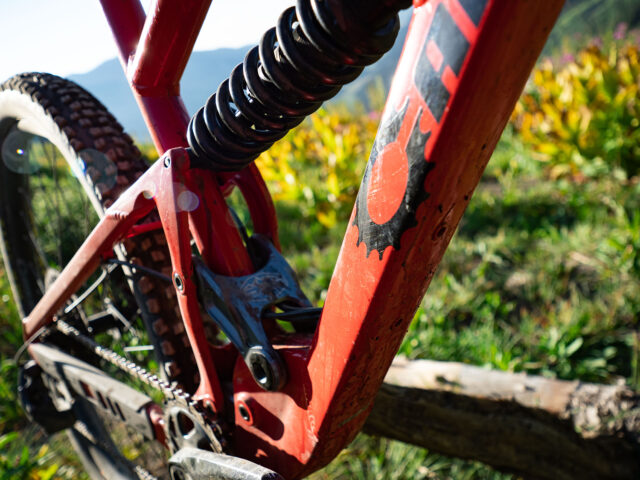
Eric Freson (5’10”, 165 lbs / 178 cm, 74.8 kg): Just a couple more thoughts on fit: first, I’d agree that the Lithium is a bike you can set up quickly and easily — there’s nothing very strange to work around here. At my height and leg length, the 170mm SDG dropper is about the longest post I could get away with comfortably, and the 475 mm reach felt plenty roomy (but not excessive). I’m also a big fan of the 165 mm cranks on these sorts of bikes where you may often be riding lifts, or looking to run a smoother and higher cadence when pedaling.
Luke Koppa (5’8”, 155 lbs / 173 cm, 70 kg): I snuck in several rides on the size Large Lithium, though Canfield recommends a size Medium for someone my height. Still, I think it’s a bike that people who are on the edges of the size chart could size up on — it doesn’t feel like a massive bike. A longer bike like the size Large Canyon Spectral definitely feels bigger than I’d prefer, but I was able to get along pretty well with the size Large Lithium. If I were buying this bike, I think I’d stick with Canfield’s recommendations and go with a Medium to make it a bit more comfortable on the climbs and even more maneuverable in tricky spots, but especially as a park bike, I really liked the Large.
Climbing
Dylan: With longer-travel bikes that encourage a “get up to get down” mentality, I am really not too picky when it comes to how efficient they are on climbs. That said, I was pretty impressed by the Lithium’s Canfield Balance Formula (CBF) suspension on the way up — it had a really nice balance of traction and efficiency.
For a big bike with plenty of suspension travel, the Lithium doesn’t exhibit much pedal bob. Most of the energy I put into the pedals felt like it went into making the bike move forward, instead of compressing the suspension. On that note, I almost never used the climb switch on the MRP Hazzard Coil on the Lithium — it just didn’t feel necessary. Canfield claims that CBF’s pedaling performance is not dependent on where the shock is in the stroke, and that actually felt true on the Lithium. It didn’t matter if I was seated and cruising along at a higher cadence or out of the saddle and putting more of my weight into the bike — the Lithium felt like it had good anti-squat throughout.
On top of having what I would call just-above-average efficiency for an Enduro bike, the Lithium doesn’t sacrifice much traction in order to get there. With the right tire pressure, the Lithium’s rear wheel tended to maintain traction pretty well on more inconsistent, technical climbs. The only places I found myself losing traction were certain points when climbing out of the saddle, but this was overall pretty rare.
With short 430 mm chainstays and a longer 815 mm front-center, the size Large Lithium biased my weight pretty heavily on the rear wheel when seated and climbing. On flatter climbs, this was no big deal. When the trail went sharply uphill and things got steep, though, I found myself having to make a concerted effort to keep my weight over the front wheel. Otherwise, I would find that the front wheel would wander or get knocked around when negotiating technical uphill moves.
I’d consider the Lithium’s effective seat tube angle (~75.7º for my 775 mm seat height) pretty average, or maybe even a bit slack by modern standards for Enduro bikes. I found myself wanting it to be a bit steeper on the numerous steep climbs we have around the Crested Butte area, such as Green Lake. On mellower, flatter climbs, it makes for a really comfortable and reasonable position, but we just don’t have a lot of those climbs out here. I really enjoyed the ~78º effective seat tube angle on Luke’s Commencal Meta TR 29, and I’d like to see something closer to that on the Lithium, given how short its chainstays are.
Eric: I found the Lithium to be a strong climber, but not in a frenetic kind of way. It feels very efficient in terms of not sucking up energy through its suspension, but it doesn’t feel snappy in how it ascends. I’d say its combination of a small chainring, short cranks, and long-ish front center all contributed to the feeling that smooth motions and steady cadence were more effective for me than big attacks and high outputs aboard the Lithium.
As Dylan points out, the biggest advantage when climbing aboard the Lithium is its consistency in its pedaling efficiency, regardless of where the shock sits in its travel. This is important in the Gunnison Valley for a couple of reasons. Because the cranks on the Lithium are short, it led me to be standing and attacking out of the saddle more than on some other bikes due to the decreased leverage on steep or technical sections of trail. The short chainstays and long front-center did also mean I often found myself working more intentionally to put weight over the front end on sustained steep climbs.
All of this is to say, I found myself moving my body position fairly frequently aboard the Lithium. Having a suspension platform that works well at any amount of sag negates many of the penalties you might associate with frequent weight and position changes while climbing. The Lithium’s composure here helped me to stay comfortable, fresh, and not fight the desire to move around on the bike while climbing, which all helped me enjoy my time pointed uphill far more than if I had felt like I needed to stay stoic in order to maximize efficiency.
I do use climb switches quite often on many bikes. However, I didn’t use it as much as I expected to on the Lithium — the climb mode on the MRP Hazzard shock is especially firm, and in many situations, I was more comfortable with the switch open. With the climb mode engaged, the suspension was so firm it could cause the bike to lose traction at the rear wheel more often than was ideal. I utilized it on road and doubletrack climbs, but if I was on singletrack, the climb switch was typically in the “open” position.
Luke: Not a whole lot to add here. The Lithium feels very efficient on the pedals without making it very difficult to maintain traction on loose, techy climbs. This was a big reason why I loved the Revel Rail (which shares the same CBF suspension design), and I really like pedaling on the Lithium for the same reasons. Especially being on a size that’s a bit big for me, there were times when I wished for a slightly steeper seat tube angle, but that was far from a dealbreaker for me. Of the longer-travel bikes I’ve used, I’d say the Lithium is one of the better climbers overall.
Descending
Dylan: With plenty of squish and big 29” wheels, the Lithium was definitely a great bike for going all-out and taking chances. And yet, I also didn’t feel that I needed to be going really hard at all times to enjoy the ride.
One of the first things I noticed when riding the Lithium was how well it cornered. Of all the long-travel 29ers I’ve been on, I think the Lithium takes the cake when it comes to cornering confidence. I’m not sure I can pin down exactly what about the Lithium creates its secure, nimble feel in corners, but I believe it comes down to its combination of short chainstays, CBF suspension, and the MRP Hazzard Coil. I found myself taking more and more speed into corners and it felt very intuitive to trust the bike around both tight, cambered corners as well as more drawn-out, flat corners.
That brings me to another point: I found that the Lithium has pretty impressive braking traction. Whether I was slowly modulating the brakes through a rock garden or less precisely pulling on them in a panic, it was hard to break the rear wheel loose and skid or skip around. This was most beneficial on loose and chunky trails, where, on other bikes, I would sometimes feel straight up out of control due to them slipping around so much. The Lithium inspired me to let off the brakes a bit more than usual since I knew that, whenever I needed the brakes, I would be able to quickly reign in the bike.
The Lithium’s suspension felt like it fell a bit more on the responsive end of the spectrum, rather than being super plush and forgiving. That said, I wouldn’t say the Lithium ever felt harsh, either. The Lithium let me push into it in corners and pump over rollers to gain speed without too much of that energy getting stolen by the rear suspension. At the same time, the Lithium smoothed out rough and chunky trails enough to allow me to stay off the brakes and let it run without feeling like I was about to get bucked off the bike. I wouldn’t say the Lithium was drastically above average in terms of how responsive / supportive it was; rather, I thought it struck a very nice balance.
As when climbing, I found that the Lithium’s longer reach and shorter chainstays preferred a more forward riding stance than many other bikes, such as the Santa Cruz Megatower or Trek Slash. This took some getting used to at first, but I quickly found that the Lithium’s proportionally long front end created a pretty big sweet spot on the bike. I found that I could push pretty hard into the front wheel in corners without losing rear traction, and I could let my body weight remain in a more neutral position during steep sections of trail, rather than needing to get my butt really far back to keep from going over the bars.
As I alluded to earlier, I didn’t just find the Lithium fun on the steepest and fastest trails. The Lithium was still pretty enjoyable (for an Enduro bike) on more mellow trails and at slower speeds. With a suspension platform that still allowed me to gain speed by pumping and didn’t get totally bogged down by every impact and upslope, the Lithium still carries speed pretty well on flatter, more flowy trails. The Lithium’s short chainstays make it easy to get this bike in the air, and combined with this bike’s cornering prowess, the Lithium is more fun than it should be on more mellow “blue” / intermediate flowy bike park trails. Manuals are also easier on the Lithium than most bikes with longer chainstays.
Eric: The Lithium is a fast bike on the descents — but it doesn’t need to be pushed hard for you to feel it come alive, so its speed can be deceptive. Aboard the Lithium, I was setting quick times on trails I ride frequently, but I wasn’t feeling like I was pushing the envelope of physical output to do so. In particular, I think a lot of this comes down to Lithium’s strong ability to maintain exit speed out of corners.
Just like the Revel Rail l spent time on, the most impressive aspect of Canfield’s CBF suspension design is its braking characteristics. CBF stays active and composed under heavy braking, so your braking points wind up being later, the rear wheel tracks the ground exceptionally actively, and the bike is incredibly composed under heaving braking and suspension squat. Being able to brake later, harder, and with less skipping and skidding leads to higher entry speeds and quicker exit speeds out of corners.
And as Dylan pointed out, something else the Lithium does very well is maintaining traction in corners. Its active but supportive rear suspension and coil shock play a big role here. But so does body positioning. You are able and encouraged by the Lithium to get over the bars in corners, and this helped me to stay on line and hit apexes with more precision than on bikes where I’m steering in corners more from the rear wheel.
I’d agree with Dylan that I’d use words like “supportive” or “responsive” to describe the Lithium’s rear suspension. This is no ultra-plush couch, nor is it a spikey / harsh mess. The rear wheel does a great job of getting up and out of the way of obstacles without unsettling the rest of the bike in the process. I felt the overall construction of the frame to be very stiff, but would not classify it as harsh. However, it was louder than some other bikes I have been on recently, with noticeable chain and cable slap noises to be heard.
I found that the Lithium didn’t need #maximumattack speeds to feel alive, and this did make it more enjoyable to ride on slower trails than I would have expected. It is still a large, long, and aggressive bike, though, and not what I’d reach for if I expected to be riding a lot of flatter, smoother trails.
Luke: Once again, Dylan and Eric hit all the highlights. Just like them, the Lithium impressed me when it came to all sorts of corners, its composure and grip under heavy braking, and its ability to not feel like a total barge on somewhat mellower trails.
In particular, I absolutely loved the Lithium in the bike park, where I mostly seek out nice berms, moderate jumps, and single-black trails with occasional rock gardens and steeper sections. I loved jumping it and it’s currently my favorite longer-travel bike for man-made flow trails like Luge and Teaser at Mt. Crested Butte. I’m definitely someone who has a bad habit of not weighting the front wheel enough in corners, but the Lithium’s reliable braking traction and geometry quickly had me riding it with a more aggressive, forward stance than I would on many other bikes.
The one other thing I’d add is that, if I were looking for a long-travel bike because I primarily wanted something that was going to stay as composed as possible in rough terrain, the Lithium wouldn’t be my absolute top pick. For example, the size ML Trek Slash seemed to absorb rough terrain and hold a line a bit better at high speeds than the size Large Lithium. At the same time, the Lithium also felt more lively and engaging on mellower trails than the Slash, so it’s just a matter of figuring out what you want out of your longer-travel bike.
The Build
Dylan: As we mentioned earlier, there’s only one complete build kit option for the Canfield Lithium, and it is a pretty solid one.
I’ve enjoyed SRAM’s GX Eagle drivetrain on several bikes so far, and the Lithium is no different. The GX Eagle drivetrain provided clean, crisp shifting, with only a little bit of adjustment needed during my time on the bike. I’ve been enjoying SRAM’s newer drivetrains this past year with their bigger 52-tooth granny gear, and the downshifting under force on SRAM’s newer GX is a definite improvement over the last iteration.
My first time on TRP Quadiem brakes was aboard the Lithium and overall, I am a fan. They have a sharper feel to them, somewhat similar to Shimano’s brakes. I do feel that Canfield needs to stock a 203 mm rotor on the rear rather than 180 mm; I found that the rear brake struggled with heat dissipation and tended to fade more than the front (they do put a 203 mm rotor up front). Compared to SRAM Code R brakes, I found the Quandiem brakes don’t have as easy of modulation, but I found stopping power and heat dissipation to be pretty equal, rotor size differences aside.
The Lithium’s CBF suspension made a lot of sense paired with a coil, and the MRP Hazzard was a good tool for the job. The Hazzard created a nice, supportive feel in corners and G-outs, and handled repeated small and medium bumps well. For larger hits, the suspension ramped up really nicely, and while I struggled to find the bottom of the travel, I also did not feel a harsh ramp up toward the end of the stroke. The high- and low-speed compression dials made it easy to tune the shock to the terrain I was on, though I wasn’t as inclined to mess with the rebound dial on the trail since it required a hex key to change.
As for the MRP Ribbon Air Fork, I had a harder time getting along with it. With low-speed compression and rebound damping, the damping aspect of the fork was fairly simple. But combined with MRP’s ramp control and their independent positive and negative air chambers, I had a hard time getting the air spring to feel exactly how I wanted it to. Don’t get me wrong — I had some moments with the Ribbon where I felt it was set up really well for the trail I was riding. But there were also many moments where the fork was either sitting too far into its travel or just not handling chatter the way I would like, and it was difficult to figure out what needed to be done to get the fork feeling the way I wanted it to. If you’re more in tune with your fork and willing to play with the independent positive and negative air chambers, you might have a different experience. I’d say most people are better off on the more common options out there from Fox and RockShox (you can also get an EXT Era Fork and Storia or Arma Coil Shock suspension on the Lithium for an extra $1,500).
I thought the Canfield Special Blend alloy wheels were a great addition to the Lithium’s build. They had a smooth feel to them without being too flimsy, and never felt harsh. We were able to put a small ding or two in them, but other than that, I never had any durability issues with them. Spoke tension remained good, and they stayed true. That said, I wasn’t as stoked on the tires. The Lithium comes stock with 2.5” Maxxis Minion DHF tires, which I generally really like. However, Eric and I had several instances of flatting on them. The EXO+ protection on these tires was just not enough for the speeds and trails that the Lithium can handle. On bikes like the Lithium, which encourage you to show little concern for chunky, rocky sections of trail, I’d like to see Canfield put some Double Down casing tires on this bike (or, if you’re running EXO+ and riding hard on an Enduro bike, you better be running some tire inserts, too).
Eric: Personally, I’d take the TRP Quadiem brakes over SRAM Codes every time. I just enjoy the lever feel of the TRPs more than the SRAMs. The bite point on the Quadiem is better defined and firmer, which just suits me better. This is personal preference and not a performance-based critique.
I found the Lithium’s Answer carbon handlebar to be very stiff. Not in a way that was a problem but, when the Canfield frame and wheels both had great compliance and absorbed noise well, it made the stiffness of the bars stand out to me.
My ass did not love the SDG seat the bike came spec’d with, but again, this is highly personal.
I did really enjoy the shorter crank arm length on this bike. This bike simply had me gravitating towards chunky trails, and having the shorter crank arms was a treat there.
I’m typically not very hard on tires. But I had a number of punctures during my time with Lithium. I *think* this is because the suspension of the Lithium never had me feeling that I needed to lift off the proverbial gas in sharp sections of trail, and as a result, I found the limits of the treads casing more than normal.
I did also struggle to get the MRP Ribbon set up to have the ride characteristics I wanted it to — much more so than my time on the shorter-travel Ribbon on the Banshee Phantom. As Dylan and I have both discussed, the Lithium encouraged you to ride with a fairly aggressive front-end weight bias. This meant that I was putting more “pressure” [Ed. note: Eric, you’re fired] on the fork to perform well, since I’m leaning on it (literally and figuratively) to do more. On mellower trails where there wasn’t as much weight over the front end, I was happy with the performance of this 170mm-travel fork. But I felt like I struggled to get the Ribbon to perform on steeper trailers or instances with sustained deep-fork cycling. Similar to Dylan, I found the Ribbon was often settling too far into its travel, or getting chattery in sections of trail with sustained large or fast impacts. I played with the rebound, MRP’s ramp control, and positive and negative air spring settings a bunch, but just never found a setup that felt good *and* wasn’t highly specific to the trail I was riding that day. The sweet spot just seemed to be very small and often felt like a bit of a moving target. I’d also say that, on a bike with a rear-end as capable as the Lithium in terms of mowing through choppy trail, I’d have enjoyed the stiffness of a larger chassis like the RockShox ZEB or Fox 38.
Luke: Agreed on all fronts. Most of the Lithium’s components did their respective jobs very well with little fuss.
As someone who typically prefers the modulation of SRAM’s brakes over the sharper bite of Shimano’s offerings, I’m actually surprised by Dylan and Eric’s thoughts on the TRP Quadiem brakes. And I’m surprised in a good way — while the Quadiem brakes do feel a bit quicker to bite once I pull on them than SRAM Code R or Guide RS brakes, the Quadiem brakes also don’t feel as “on / off” as some Shimano brakes I’ve used. So at least for me, they kinda hit a “best of both worlds” middle ground in terms of modulation. That said, if I were picking a TRP brake to put on the Lithium, I think I’d prefer the more powerful DH-R EVO. The Quadiem feels more powerful and more consistent over long descents than the SRAM Guide RS, but as someone who’s on the brakes a lot when the terrain gets steep, I wouldn’t have minded something with just a bit more oomph than the Quadiem (and I’m sure a larger rear rotor would’ve helped, as Dylan noted).
I’m also in agreement when it comes to the Lithium’s suspension bits. I had zero qualms with the Hazzard Coil shock — it seemed very well paired with the bike’s CBF design. The Ribbon Air seemed like less of an ideal combination. The fork’s overall performance was far from some glaring issue for me and I think those who love to tinker with their suspension may view the Ribbon as a positive on the Lithium. I found that I could get it set up to be “pretty good,” but I had a harder time getting it closer to “perfect” than I have with a Fox 36 or RockShox Lyrik and ZEB. Like Eric, I was also much happier with the Ribbon Air on the shorter-travel Banshee Phantom than I was with it on the longer-travel Lithium. I’d be very curious to try this bike with one of the newer, beefier single-crown forks on the market, since I think that could potentially further improve its performance in both steep terrain and chunky, off-camber sections.
Not technically related to the build, but I was kind of surprised to see that the Lithium does not come stock with any downtube protection. Granted, its paint does seem quite good and I didn’t manage to chip it during my brief time with the bike, but it would be nice to see some sort of protection added in high-wear areas. If I bought this bike, I’d definitely add some stick-on protection to the downtube and bottom bracket area, and maybe add more to the chainstays and seat stays to help reduce chain slap notes.
Lastly, I’d just like to commend Canfield for the price-to-performance ratio of the Lithium’s build kit. While $5,599 is by no means a small amount of money, these days, I think the Lithium is a pretty good deal for what you get.
Who’s It For?
Dylan: There are a couple of types of riders who I believe could get along well with the Lithium.
(1) Riders looking for an Enduro bike, but who are worried about losing versatility
The Lithium is competitive to most Enduro bikes on the market when it comes to things like high-speed stability and a smooth feel through harsh rock gardens. However, the Lithium also doesn’t feel quite as sluggish or cumbersome on mellower trails, thanks to its efficient suspension and shorter chainstays. If you want a versatile longer-travel bike, the Lithium definitely deserves to be on your list.
(2) Riders looking for an Enduro bike that is still playful
The Lithium is easy to get into the air, easy to flick around, and has a nimble feel to it (for a bike in its travel class). This all creates a ride that is a bit more playful than most other Enduro bikes, which can sometimes be much more one-dimensional. I found that this makes the Lithium a really good time in the park, where you can both ride it hard on DH-track-type trails and also enjoy it on jump trails, even mellower ones.
Bottom Line
Dylan: With the Lithium, Canfield set out to make a capable bike designed to be at home in the bike park and on Enduro race tracks. I believe they accomplished this without making the Lithium a one-trick pony – it is an impressive climber for its class, and it is lively and nimble enough to still be fun on mellower trails. Riders looking to get maximum versatility out of their Trail bike have better, shorter-travel options, but the Canfield Lithium makes a pretty compelling case as a versatile Enduro bike.
Eric: I really enjoy Canfield’s CBF suspension. Like, a lot. And I think it once again works quite well on the Lithium platform. The Lithium is very good at maintaining speed on the descents, while also being far more utilitarian everywhere than you might believe. For as much speed as it can carry going downhill, it doesn’t really come across as having a super race-oriented character or feel, making it feel far more practical for everyday non-”max attack” riding efforts than some other bikes in this category and travel range. If that sounds enjoyable to you, it’s worth checking out. If, however, you want your long-travel bike to “feel” like an Enduro race bike (i.e., single-minded toward fast descents), the Lithium might not be the bike you are looking for.
Luke: There are lots of good, long-travel bikes out there these days, so it’s all a matter of figuring out what sort of long-travel bike you want. The Lithium stands out from the rest because it’s efficient on the climbs, surprisingly maneuverable and enjoyable in non-gnarly terrain, and still more composed than most shorter-travel bikes when speeds are high.

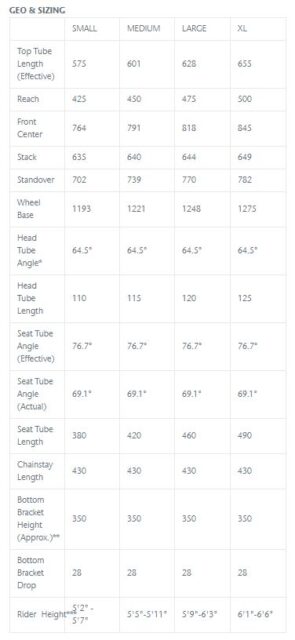


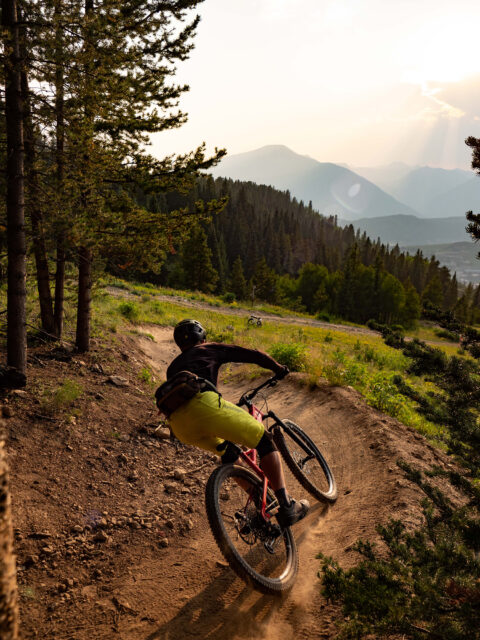
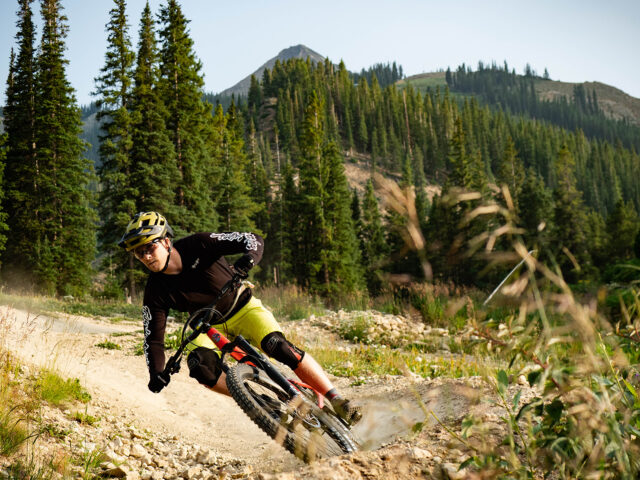
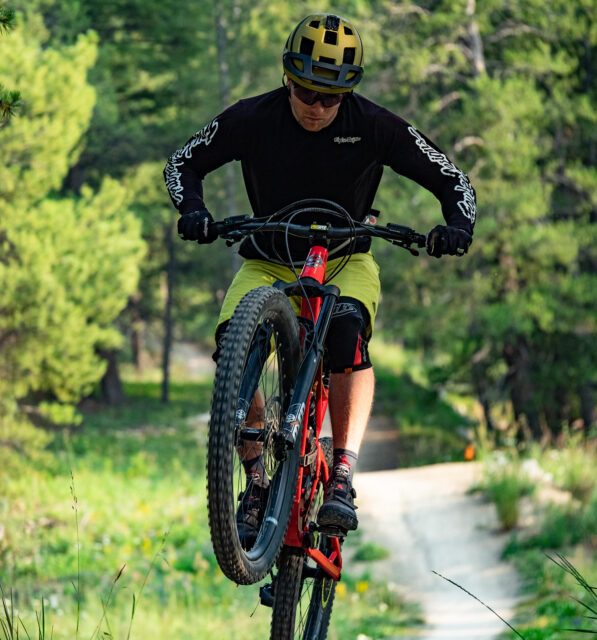

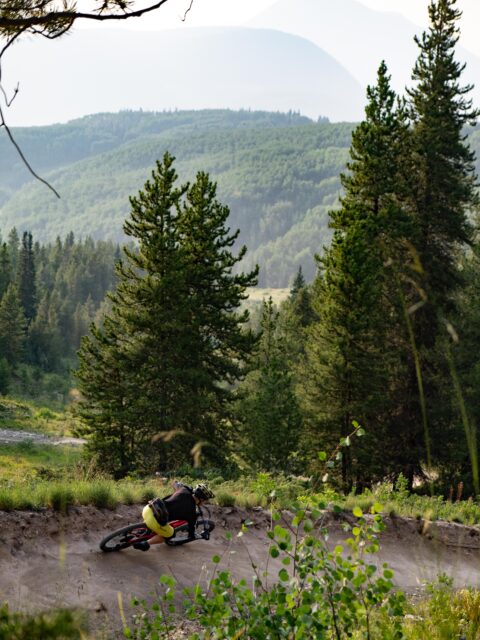
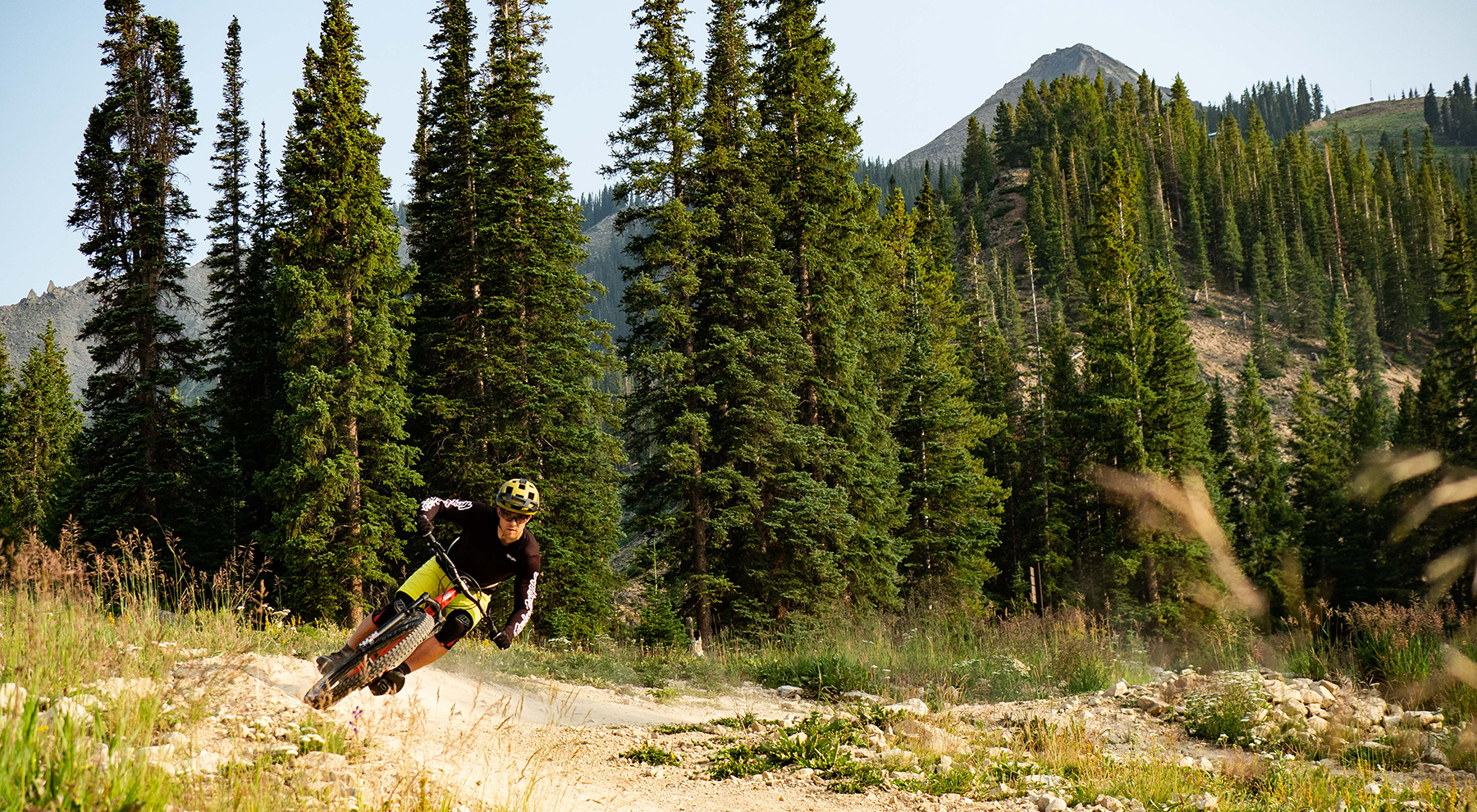
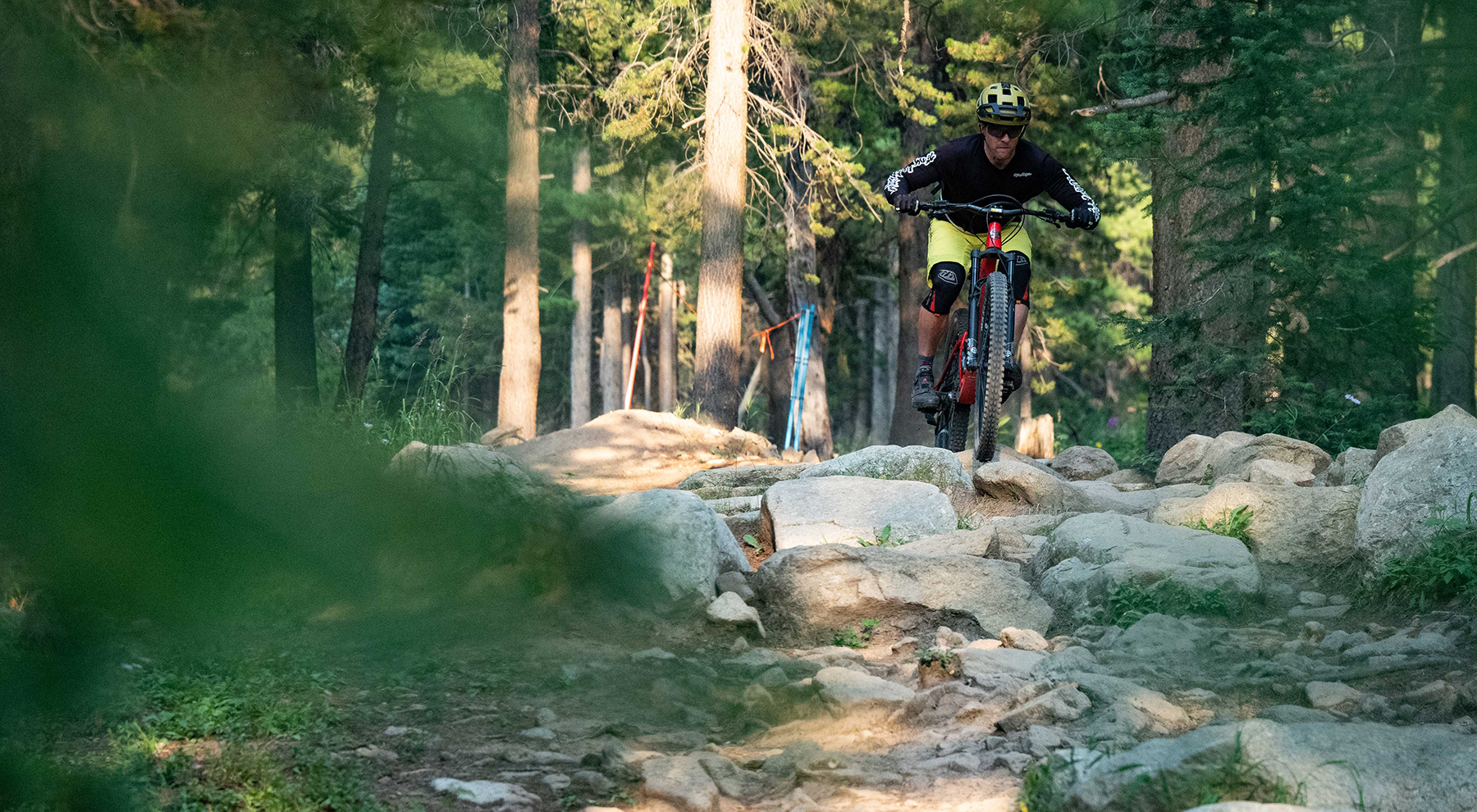
Sounds great, like a bigger Ripmo. Still looking for a review of a trail build One.2…
It’s hard to say without getting on a ripmo ourselves, but I could see some similarities there.
A One.2 built as a trail bike would be a pretty sweet rig, maybe someday…
Have y’all considered having some sort of standard component package to swap onto bikes to dig down into some of the frame and suspension specifics? I see the value in testing bikes as they are sold in terms of full builds but it seems like having a period where you swap on your “standard” trail build, enduro build, fill-in-the-blank build components would help standardize some of the comparison. Especially when looking at bikes w/ less common builds like MRP Ribbon forks and TRP brakes. I’ve had this question before but this review it really stood out to me because of the components and feedback. Y’all had a pretty consistent experience on the bike in terms of feel/pros/cons but some of those positives/negatives seem to also overlap with positives/negatives of less standard components. If you had a dialed 36 you always threw on, standard brakes/rotors, and a standard wheel set it seems like you could more accurately compare bikes. But that requires more components/money so maybe I’m asking for an increase in membership dues (not sure I could swing that, but I’ll keep trying to recruit more folks :-)).
Hey Wes,
It’s a good thought, and we do sometimes swap specific parts around on review bikes if we feel that there’s a reason to. We’ll try a bike stock, and if something feels like it’s holding the bike back, we’ll sometimes swap it out to confirm, then comment on what we changed and why in the review. I think overall that’s a more realistic way forward than testing everything with the same reference build for many of the reasons you already touched on, but I also think it’s a good way to approach the review process. In many cases there isn’t a compelling reason to swap parts, and for those bikes tearing them down and putting a new build on them (twice, once to go to the reference build and then again to send it back) would just add time and cost to the review process for not much benefit.
That said, we definitely can and will do targeted swaps more in the future, and are talking internally about how best to make that happen. So, thanks for the feedback and we will be incorporating more part adjustments as appropriate going forward.
Was there any riding done with it in the 151mm rear travel? I’d be interested if it was more playful and more suited as an AM bike with the shorter stroke.
You can always just run less sag to get the same result. Unless you want to bottom out more. These different stroke travel options are kinda silly in my opinion.
I know my comment is late to the party here, but having owned a Lithium for little over a year, I would have to agree with all the comments the testers have mentioned. Prior to the Lithium I had a 2020 Commencal Meta AM 29 and a 2018 Santa Cruz Nomad (lower link), and in comparison to those bikes the Lithium climbs far better (even without the climb switch), and feels much better on terrain that isn’t quite as steep. Its not all the time that I ride my enduro bike on DH trails or bike park. There might be some really hairy bits of the trail, but you still have to get there, and the Lithium is the perfect bike for this. I have done 5000ft vert days on the bike, sometimes past 13k elevation, and its up to the task. I have taken this bike to Whistler twice (I live in Denver Colorado), and it shreds all the double black trails in the Whistler Bike Park and surrounding XC-Gnar double blacks. I will say, at speed, its not quite as calm as the Nomad or Meta AM, but it doesn’t slow the bike down, and you just find yourself picking slightly different lines at the same rate of speed. In fact, I like this bike so much, that I just picked up a Canfield Tilt for some more XC riding. Id also like to point out that Canfield are a super cool and easy company to deal with, their frame are really well made, the powder coat is nearly chip proof, and their after sales support is great.